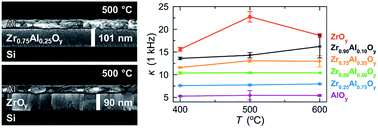Tunable high-κ ZrxAl1−xOy thin film dielectrics from all-inorganic aqueous precursor solutions†
Abstract
Zirconium oxide has received considerable attention as a dielectric component for microelectronic applications. However, crystallization at relatively low temperatures results in the formation of grain boundaries and high leakage current densities. Doping ZrOy with Al is known to suppress crystallization, but the effects of Al incorporation on dielectric properties has not been investigated over the complete range of Zr : Al compositions in ZrxAl1−xOy (ZAO). Herein, we report an aqueous, all-inorganic route to amorphous high-κ ZAO thin film dielectrics with varying Zr : Al composition. ZAO thin films were spin-cast and annealed at temperatures between 200 and 600 °C to produce dense, uniform, and smooth films with sub-nm roughness. In general, Zr-rich films had higher dielectric constants, ranging from 18.6 for pure ZrOy to 5.4 for pure AlOy (1 kHz), while Al-rich films had lower leakage current densities. Of the compositions studied, Zr0.75Al0.25Oy films displayed the optimal balance of dielectric properties and low leakage current densities, making them promising candidates for microelectronic devices.



 Please wait while we load your content...
Please wait while we load your content...